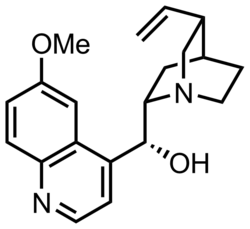Quinine
An article about the use of quinine in medicine
| Quinine | |
|---|---|

| |
| INN | |
| Drug class | |
| Routes of administration | |
| Pregnancy category | |
| Bioavailability | |
| Metabolism | |
| Elimination half-life | |
| Excretion | |
| Legal status | |
| CAS Number | |
| PubChem | |
| DrugBank | |
| ChemSpider | |
| KEGG | |
Quinine is a medication used to treat malaria and babesiosis. It is a naturally occurring alkaloid derived from the bark of the Cinchona tree. Quinine has been used for centuries as an effective treatment for malaria, a disease caused by Plasmodium parasites transmitted through the bites of infected Anopheles mosquitoes.
History[edit]
The use of quinine dates back to the early 17th century when it was first introduced to Europe by Jesuit missionaries. The bark of the Cinchona tree, native to the Andean forests of South America, was used by indigenous people to treat fevers. The active ingredient, quinine, was isolated in 1820 by French researchers Pierre Joseph Pelletier and Joseph Bienaimé Caventou.
Mechanism of Action[edit]
Quinine works by interfering with the growth and reproduction of the malaria parasite in the red blood cells. It inhibits the parasite's ability to digest hemoglobin, leading to the accumulation of toxic heme molecules, which ultimately kills the parasite.
Medical Uses[edit]
Quinine is primarily used to treat uncomplicated Plasmodium falciparum malaria. It is often used in combination with other antimalarial drugs to enhance efficacy and reduce the risk of resistance. Quinine is also used off-label to treat nocturnal leg cramps, although this use is controversial due to potential side effects.
Side Effects[edit]
Common side effects of quinine include cinchonism, which is characterized by symptoms such as tinnitus, headache, nausea, and visual disturbances. More severe side effects can include thrombocytopenia, hemolytic anemia, and arrhythmias. Due to these potential adverse effects, quinine use is generally limited to cases where other treatments are not available or suitable.
Biosynthesis[edit]

Quinine is biosynthesized in the Cinchona tree through a complex pathway involving several enzymatic steps. The process begins with the amino acid tryptophan and involves the formation of several intermediate compounds before the final quinine molecule is produced.
Cultural and Other Uses[edit]
Quinine is also known for its use in tonic water, where it is responsible for the drink's distinctive bitter taste. Under ultraviolet light, tonic water fluoresces due to the presence of quinine, as shown in the image above.
Also see[edit]
References[edit]
<references group="" responsive="1"></references>
Ad. Transform your life with W8MD's Budget GLP-1 injections from $75


W8MD offers a medical weight loss program to lose weight in Philadelphia. Our physician-supervised medical weight loss provides:
- Weight loss injections in NYC (generic and brand names):
- Zepbound / Mounjaro, Wegovy / Ozempic, Saxenda
- Most insurances accepted or discounted self-pay rates. We will obtain insurance prior authorizations if needed.
- Generic GLP1 weight loss injections from $75 for the starting dose.
- Also offer prescription weight loss medications including Phentermine, Qsymia, Diethylpropion, Contrave etc.
NYC weight loss doctor appointmentsNYC weight loss doctor appointments
Start your NYC weight loss journey today at our NYC medical weight loss and Philadelphia medical weight loss clinics.
- Call 718-946-5500 to lose weight in NYC or for medical weight loss in Philadelphia 215-676-2334.
- Tags:NYC medical weight loss, Philadelphia lose weight Zepbound NYC, Budget GLP1 weight loss injections, Wegovy Philadelphia, Wegovy NYC, Philadelphia medical weight loss, Brookly weight loss and Wegovy NYC
|
WikiMD's Wellness Encyclopedia |
| Let Food Be Thy Medicine Medicine Thy Food - Hippocrates |
Medical Disclaimer: WikiMD is not a substitute for professional medical advice. The information on WikiMD is provided as an information resource only, may be incorrect, outdated or misleading, and is not to be used or relied on for any diagnostic or treatment purposes. Please consult your health care provider before making any healthcare decisions or for guidance about a specific medical condition. WikiMD expressly disclaims responsibility, and shall have no liability, for any damages, loss, injury, or liability whatsoever suffered as a result of your reliance on the information contained in this site. By visiting this site you agree to the foregoing terms and conditions, which may from time to time be changed or supplemented by WikiMD. If you do not agree to the foregoing terms and conditions, you should not enter or use this site. See full disclaimer.
Credits:Most images are courtesy of Wikimedia commons, and templates, categories Wikipedia, licensed under CC BY SA or similar.
Translate this page: - East Asian
中文,
日本,
한국어,
South Asian
हिन्दी,
தமிழ்,
తెలుగు,
Urdu,
ಕನ್ನಡ,
Southeast Asian
Indonesian,
Vietnamese,
Thai,
မြန်မာဘာသာ,
বাংলা
European
español,
Deutsch,
français,
Greek,
português do Brasil,
polski,
română,
русский,
Nederlands,
norsk,
svenska,
suomi,
Italian
Middle Eastern & African
عربى,
Turkish,
Persian,
Hebrew,
Afrikaans,
isiZulu,
Kiswahili,
Other
Bulgarian,
Hungarian,
Czech,
Swedish,
മലയാളം,
मराठी,
ਪੰਜਾਬੀ,
ગુજરાતી,
Portuguese,
Ukrainian